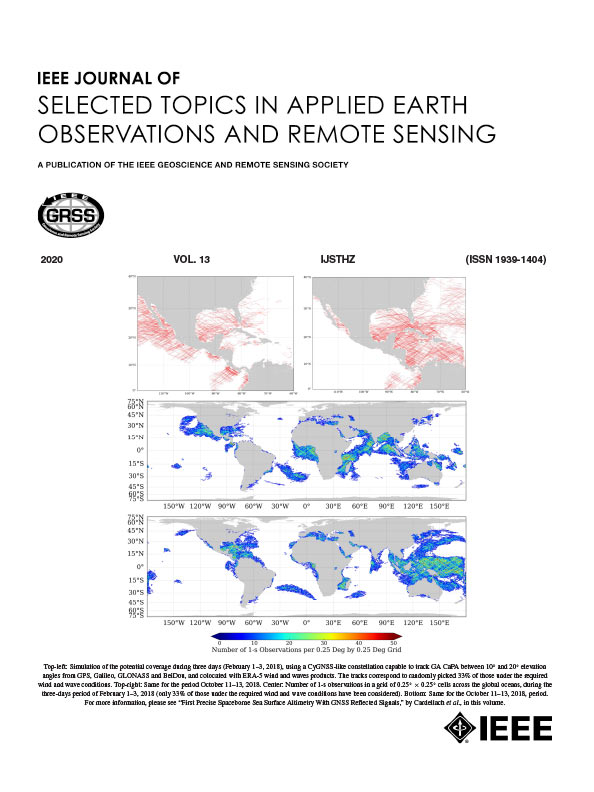HCAFNet: Hierarchical Cross-Modal Attention Fusion Network for HSI and LiDAR Joint Classification
IF 4.7
2区 地球科学
Q1 ENGINEERING, ELECTRICAL & ELECTRONIC
IEEE Journal of Selected Topics in Applied Earth Observations and Remote Sensing
Pub Date : 2025-03-28
DOI:10.1109/JSTARS.2025.3555950
引用次数: 0
Abstract
Hyperspectral image (HSI) and light detection and ranging (LiDAR) data can provide complementary features and have shown great potential for land cover classification. Recently, the joint classification using the HSI and LiDAR data based on deep learning networks (e.g., convolutional neural networks and transformers) have made progress. However, these methods often use the channel or spatial dimension attentions to highlight features, which overlook the interdependencies between these dimensions and face challenges in effectively extracting and fusing diverse features from heterogeneous datasets. To address these challenges, a novel hierarchical cross-modal attention fusion network (HCAFNet) is proposed in this manuscript. First, a hierarchical convolution module is designed to extract diverse features from multisource data and to achieve initial fusion using the octave convolution. Then, a bidirectional feature fusion module is constructed to integrate heterogeneous features within the network. To further enhance the network's feature representation capability, a triplet rotational multihead attention module is designed to capture cross-dimensional dependencies, enabling more effective representation of both channel and spatial information. Experimental results conducted on three public datasets demonstrate that the proposed HCAFNet outperforms other advanced methods.HCAFNet:用于HSI和LiDAR联合分类的分层跨模态注意力融合网络
高光谱图像(HSI)和光探测和测距(LiDAR)数据可以提供互补的特征,并在土地覆盖分类方面显示出巨大的潜力。近年来,基于深度学习网络(如卷积神经网络和变压器)的HSI和LiDAR数据联合分类取得了进展。然而,这些方法通常使用通道或空间维度关注来突出特征,忽略了这些维度之间的相互依赖关系,在有效提取和融合异构数据集中的各种特征方面面临挑战。为了解决这些挑战,本文提出了一种新的分层跨模态注意力融合网络(HCAFNet)。首先,设计了分层卷积模块,从多源数据中提取不同特征,并利用八度卷积实现初始融合;然后,构建双向特征融合模块,实现网络内异构特征的融合;为了进一步增强网络的特征表示能力,设计了一个三重旋转多头注意模块来捕获跨维依赖性,从而能够更有效地表示信道和空间信息。在三个公共数据集上进行的实验结果表明,HCAFNet优于其他先进的方法。
本文章由计算机程序翻译,如有差异,请以英文原文为准。
求助全文
约1分钟内获得全文
求助全文
来源期刊
CiteScore
9.30
自引率
10.90%
发文量
563
审稿时长
4.7 months
期刊介绍:
The IEEE Journal of Selected Topics in Applied Earth Observations and Remote Sensing addresses the growing field of applications in Earth observations and remote sensing, and also provides a venue for the rapidly expanding special issues that are being sponsored by the IEEE Geosciences and Remote Sensing Society. The journal draws upon the experience of the highly successful “IEEE Transactions on Geoscience and Remote Sensing” and provide a complementary medium for the wide range of topics in applied earth observations. The ‘Applications’ areas encompasses the societal benefit areas of the Global Earth Observations Systems of Systems (GEOSS) program. Through deliberations over two years, ministers from 50 countries agreed to identify nine areas where Earth observation could positively impact the quality of life and health of their respective countries. Some of these are areas not traditionally addressed in the IEEE context. These include biodiversity, health and climate. Yet it is the skill sets of IEEE members, in areas such as observations, communications, computers, signal processing, standards and ocean engineering, that form the technical underpinnings of GEOSS. Thus, the Journal attracts a broad range of interests that serves both present members in new ways and expands the IEEE visibility into new areas.

 求助内容:
求助内容: 应助结果提醒方式:
应助结果提醒方式:


